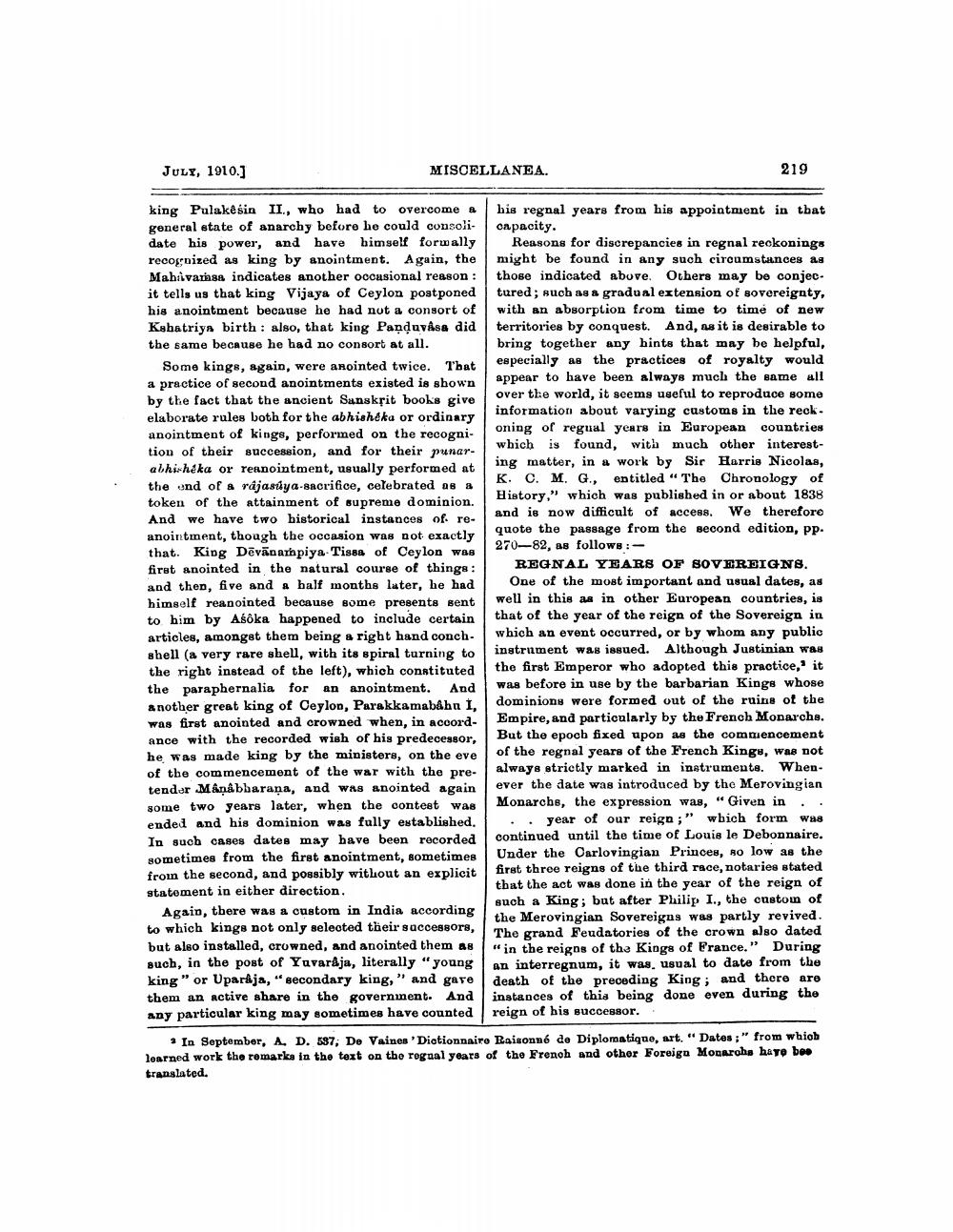________________
JULY, 1910.]
king Pulakêsin II., who had to overcome a general state of anarchy before he could consolidate his power, and have himself formally recognized as king by anointment. Again, the Mahavamsa indicates another occasional reason: it tells us that king Vijaya of Ceylon postponed his anointment because he had not a consort of Kshatriya birth: also, that king Panduvasa did the same because he had no consort at all.
MISCELLANEA.
Some kings, again, were anointed twice. That a practice of second anointments existed is shown by the fact that the ancient Sanskrit books give elaborate rules both for the abhisheka or ordinary anointment of kings, performed on the recognition of their succession, and for their punarabhisheka or reanointment, usually performed at the end of a rájasúya-sacrifice, celebrated as a token of the attainment of supreme dominion. And we have two historical instances of reanointment, though the occasion was not exactly that. King Devanampiya Tissa of Ceylon was first anointed in the natural course of things: and then, five and a half months later, he had himself reanointed because some presents sent to him by Asôka happened to include certain articles, amongst them being a right hand conchshell (a very rare shell, with its spiral turning to the right instead of the left), which constituted the paraphernalia for an anointment. And another great king of Ceylon, Parakkamabahu I, was first anointed and crowned when, in accordance with the recorded wish of his predecessor, he was made king by the ministers, on the eve of the commencement of the war with the pretender Mânâbharana, and was anointed again. some two years later, when the contest was ended and his dominion was fully established. In such cases dates may have been recorded sometimes from the first anointment, sometimes from the second, and possibly without an explicit statement in either direction.
Again, there was a custom in India according to which kings not only selected their successors, but also installed, crowned, and anointed them as such, in the post of Yuvaraja, literally "young king" or Uparaja, "secondary king," and gave them an active share in the government. And any particular king may sometimes have counted
219
his regnal years from his appointment in that capacity.
Reasons for discrepancies in regnal reckonings might be found in any such circumstances as those indicated above. Others may be conjec. tured; such as a gradual extension of sovereignty, with an absorption from time to time of new territories by conquest. And, as it is desirable to bring together any hints that may be helpful, especially as the practices of royalty would appear to have been always much the same all over the world, it seems useful to reproduce some information about varying customs in the reckoning of regual years in European countries which is found, with much other interesting matter, in a work by Sir Harris Nicolas, K. C. M. G., entitled "The Chronology of History," which was published in or about 1838 and is now difficult of access. We therefore quote the passage from the second edition, pp. 270-82, as follows:
REGNAL YEARS OF SOVEREIGNS. One of the most important and usual dates, as well in this as in other European countries, is that of the year of the reign of the Sovereign in which an event occurred, or by whom any public instrument was issued. Although Justinian was the first Emperor who adopted this practice,' it was before in use by the barbarian Kings whose dominions were formed out of the ruins of the Empire, and particularly by the French Monarchs. But the epoch fixed upon as the commencement of the regnal years of the French Kings, was not always strictly marked in instruments. Whenever the date was introduced by the Merovingian Monarchs, the expression was, "Given in ... year of our reign;" which form was continued until the time of Louis le Debonnaire. Under the Carlovingian Princes, so low as the first three reigns of the third race, notaries stated that the act was done in the year of the reign of such a King; but after Philip I., the custom of the Merovingian Sovereigns was partly revived. The grand Feudatories of the crown also dated "in the reigns of the Kings of France." During an interregnum, it was, usual to date from the death of the preceding King; and there are instances of this being done even during the reign of his successor.
2 In September, A. D. 537, De Vaines 'Dictionnaire Raisonné de Diplomatique, art. "Dates;" from which learned work the remarks in the text on the regnal years of the French and other Foreign Monarchs have bee translated.




